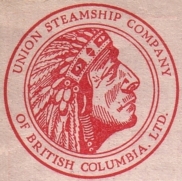Willapa Bay is a large shallow body of water near the Pacific Ocean in southwestern Washington. For a number of years before modern roads were built in Pacific County, Washington, the bay was used as the means of travel around the county, by powered and unpowered craft, including several steamboats.

The King and Winge Shipbuilding Company was an important maritime concern in the early 1900s on Puget Sound. The shipyard was located at West Seattle. The owners were Thomas J. King (1843–1925) and Albert M Winge. King was born in Boston and learned to build ships under the famous Donald McKay. He came to Puget Sound in about 1880, and worked in the shipyards of Hall Bros. and T.W. Lake before starting his own shipyard with Winge. King’s partner, Albert L. Winge was a native of Norway.

The steamboat Monticello (2) operated in the early 1900s as part of the Puget Sound Mosquito Fleet. The vessel went through several reconstructions and remained in service until 1962, when she was lost in Alaska waters. Her later names were Penaco and Sea Venture. (This Puget Sound steamer should not be confused with the smaller Monticello, which also ran on Puget Sound, but was built in 1895 for Captain Z.J. Hatch of the Monticello Steamship Company.

The steamboat George E. Starr operated in late 19th century as part of the Puget Sound Mosquito Fleet and also operated out of Victoria, B.C. Geo. E. Starr also served for a time in California and on the Columbia River.

Flyer was an American steamboat that served from 1891 to 1929 on Puget Sound. From 1918 until the end of her service, she was officially known as the Washington. The Flyer ran for millions of miles at high speed, more than any inland vessel in the world. This 1891 steamer Flyer should not be confused with the steamboat Flyer built on Lake Coeur d'Alene in 1905, although the Coeur d'Alene vessel was inspired both in design and name by the success of the Puget Sound ship.

The Union Steamship Company of British Columbia was a pioneer firm on coastal British Columbia. It was founded in November 1889 by John Darling, a director of the Union Steamship Company of New Zealand, and nine local businessmen. The company began by offering local service on Burrard Inlet near Vancouver and later expanded to servicing the entire British Columbia coast.

Tacoma was a steamship that served from 1913 to 1938 on Puget Sound. Built of steel, Tacoma was known for being one of the fastest and best-designed vessels to operate on Puget Sound. Tacoma was particularly noted for high-speed service from 1913 to 1930 on the route between Tacoma and Seattle.

Hyak was a wooden-hulled steamship that operated on Puget Sound from 1909 to 1941. This vessel should not be confused with the sternwheeler Hyak which ran on the extreme upper reach of the Columbia River at about the same time. The name means "swift" or "fast" in the Chinook Jargon.
The La Conner Trading and Transportation Company was founded in the early 1900s by Joshua Green and others, to engage in the shipping business on Puget Sound.

Lady of the Lake was a wooden steamboat that operated on Puget Sound from 1897 to 1903. Following a fire in 1903, the vessel was rebuilt as the tug Ruth.

Richard Holyoke was a seagoing steam tug boat built in 1877 in Seattle, Washington and which was in service on Puget Sound and other areas of the northwest Pacific coast until 1935. The vessel was considered to be one of the most powerful tugs of its time.
Comet was a sternwheel steamboat that ran from 1871 to 1900 on Puget Sound and rivers flowing into it, including the White and Nooksack rivers.

Inland Flyer was a passenger steamboat that ran on Puget Sound from 1898 to 1916. From 1910 to 1916 this vessel was known as the Mohawk. The vessel is notable as the first steamer on Puget Sound to use oil fuel. Inland Flyer was one of the most famous vessels of the time on Puget Sound.

General Miles was a steamship constructed in 1882 which served in various coastal areas of the states of Oregon and Washington, as well as British Columbia and the territory of Alaska. It was apparently named after US General Nelson A. Miles.

Kulshan was a steamship which operated on Puget Sound from 1910 until 1929. When built, Kulshan was one of a newer type of inland steamships constructed entirely of steel, and was then considered one of the finest vessels ever to operate on Puget Sound.

Potlatch was a steamship which was operated on Hood Canal from 1912 to 1917, on Puget Sound from 1917 to 1937, although the vessel was little used after 1917.

Sol Duc was a steamship which was operated on northern Puget Sound from 1912 to 1935, chiefly on a route connecting ports on the Olympic Peninsula with Seattle. During the Second World War (1941–1945) Sol Duc served as a barracks ship.

Sioux was a steamship which was operated on Puget Sound and the Strait of Juan de Fuca from 1912 to 1941. From 1924 to 1941, following reconstruction, the vessel operated as an auto ferry under the name Olympic. During the Second World War (1941-1945) this vessel was taken under the control of the U.S. Army and renamed the Franklin R. Leisenburg. The Liesenburg served as a ferry in the Panama Canal area under Army control, and then was sold to a firm which ran the vessel on the Surinam river in South America.

Suquamish, built in 1914, was the first diesel-engined passenger vessel in the United States. Much later Suquamish was converted to a commercial fishing vessel and was registered as a Canadian vessel under the name Terry.

Speeder was a motor launch built in 1908 which served on Puget Sound and in the San Juan Islands. From 1908 to 1922 this vessel was named Bainbridge.


















